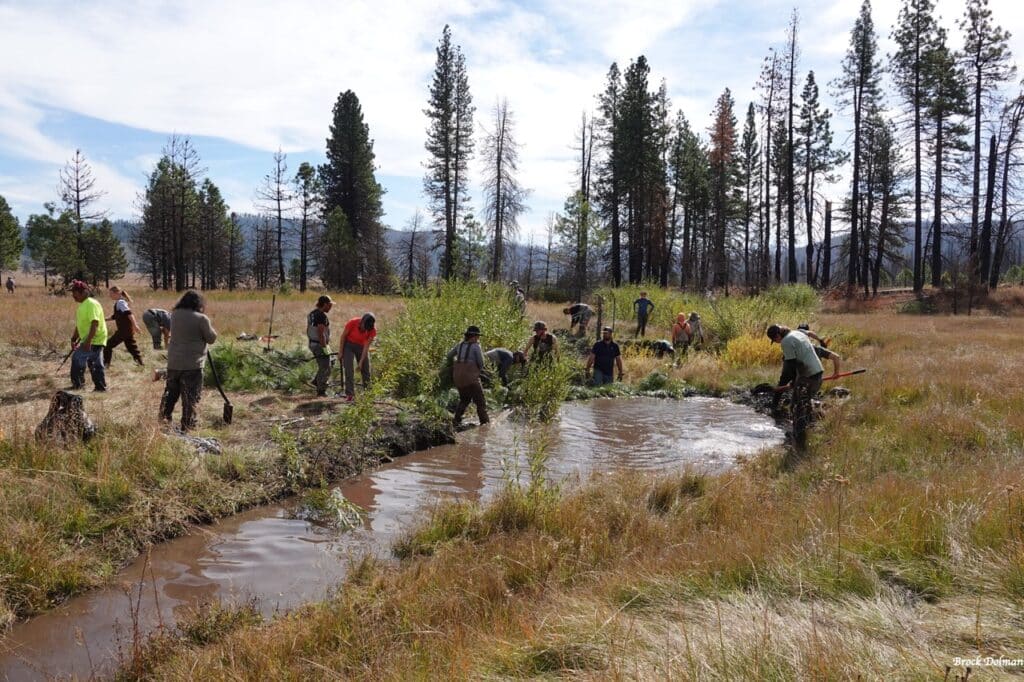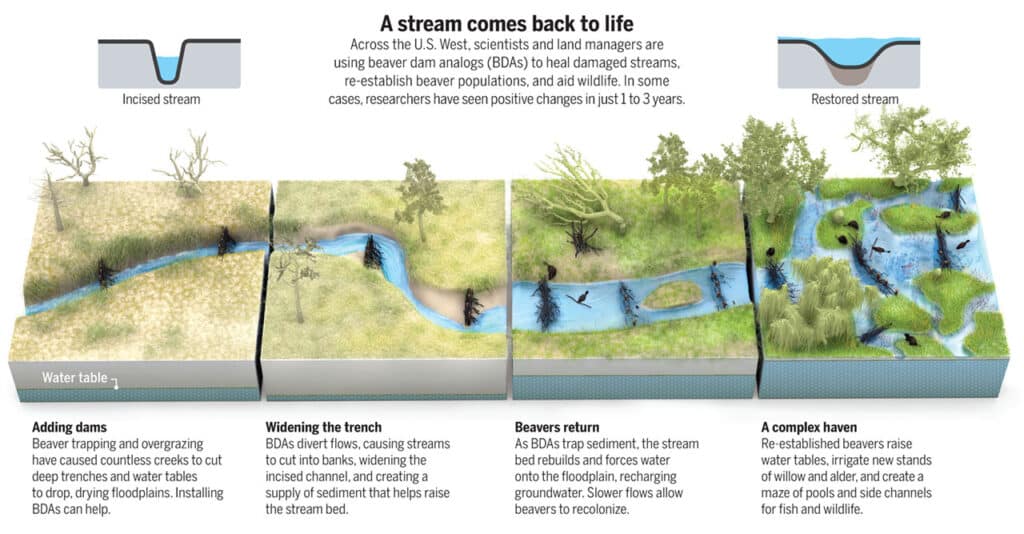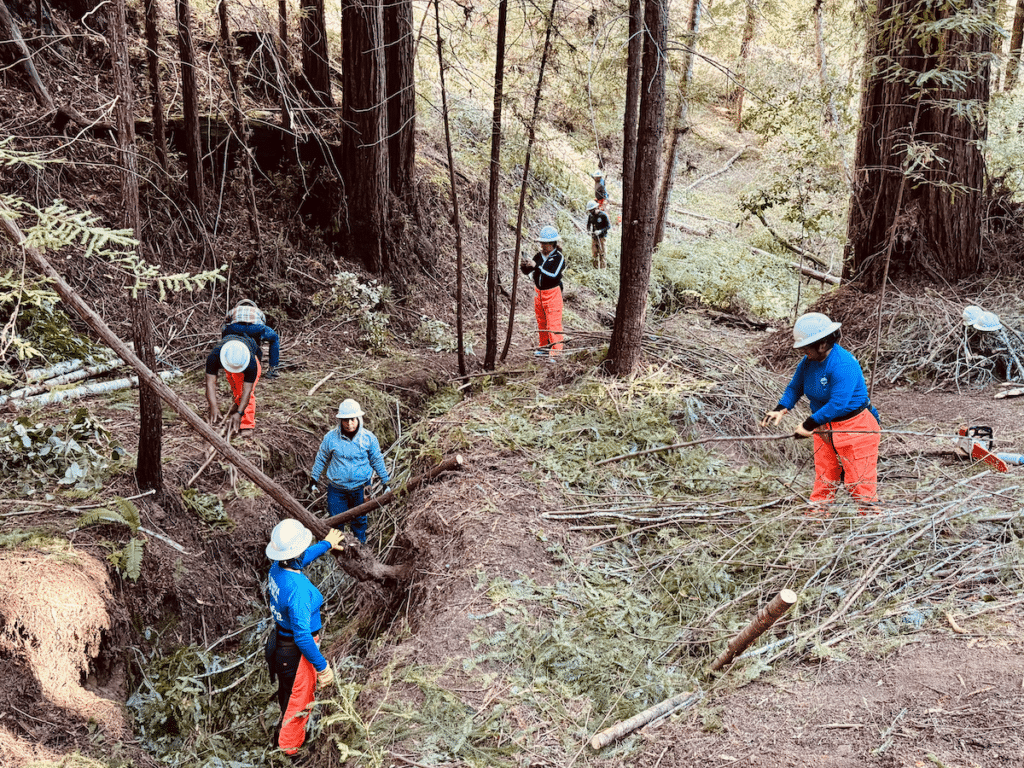
Process-Based Restoration from Ridgeline to Reef
Process-based restoration (PBR) is a holistic approach to restoring degraded watersheds that aims to re-establish keystone processes such as sediment transport, carbon sequestration, nutrient cycling, and fire resiliency. Process-based restoration considers the functions and needs of the entire watershed – from ridgeline to reef – and seeks to harness naturally occurring, onsite energy and materials to achieve upland, river, wetland, floodplain, and estuary restoration goals. A stewardship mentality guides PBR practices. They are adaptive over time to environmental feedback with the goal of encouraging a self-sustaining, dynamic ecosystem.
PBR is different from “form-based” restoration in that PBR typically uses low-tech, low-emissions, and hand-scaled solutions with natural materials that are meant to eventually break down and become part of living and evolving ecosystems. While form-based, fixed solutions are appropriate in certain scenarios where there is a need to stabilize a system and reduce dynamism (to protect infrastructure, for example), PBR invites us to carefully consider the needs of the site. Rather than automatically turning to expensive solutions with lots of concrete and heavy machinery, whenever possible, PBR opts for lighter-touch, lower-impact solutions where nature does the work for us.
Drawing from permaculture principles and ethics, OAEC promotes and demonstrates interdisciplinary applications of PBR. We encourage the integration of often-siloed techniques, practitioners, and agencies toward a whole-systems, whole-watershed approach to land management. Two major areas of PBR where OAEC’s WATER Institute and Wildlands Program have had the most impact are the Bring Back the Beaver Campaign and the Fuels to Flows Campaign.

Process-Based Restoration in the Riverscape
Most rivers, floodplains, and estuaries in the arid West are degraded and compromised due to development, diversion, pollution, industrial agriculture, and other destructive land use practices. Ecologists and restoration practitioners are being asked to address habitat loss, erosion and sediment overload, increasing extremes of deluge and drought, and the whole host of intertwined, compounding impacts of climate change.
Fortunately, PBR offers a set of useful design principles that leverage time, space, energy, and materials that are effective and low-cost and that restore ecological functions. Consider the Riverscape Principles laid out by our colleagues at Utah State University in their excellent Low-Tech Process-Based Restoration of Riverscapes pocket guide, including the ideas that streams need space, that it’s ok to be messy, or that inefficient conveyance of water is often healthy. We also recommend the Design Criteria for Process-Based Restoration of Fluvial Systems Ciotti et al., 2021 for inspiration on PBR concepts for maximizing ecological value with minimal inputs. The California Process-Based Restoration (CalPBR) Network was co-founded by OAEC in 2022 as a hub for restoration professionals and is a great resource for finding skills trainings, ideas, or a professional to help with your project.

Image source: Science Advisor Magazine https://www.science.org/doi/10.1126/science.360.6393.1058
Beaver as Agents of Process-Based Restoration
We look to beaver as agents of process-based restoration who actively shape landscapes and promote natural ecological processes. Beaver dams and associated ponds help mitigate the impacts of climate change, drought, and wildfire by sequestering carbon, increasing surface and groundwater storage, attenuating flood waters, and creating wildfire-resistant riverscapes that serve as critical “refugia” for species unable to escape fire. Beaver dams improve water quality, repair eroded channels, reconnect streams to their floodplains, and create and maintain wetland and riparian habitats.
Beaver create habitat complexity and diversity in otherwise simplified stream systems and can prolong critical summer streamflow or provide perennial flow to degraded urban and wildland streams that would otherwise run dry. Beaver dams, canals, burrows, and food caches greatly expand wetland and wet meadow habitats, create refugia from predation and high flows, and provide many other ecosystem benefits to imperiled fish, birds, and amphibians. Beaver activities exemplify how a single species can profoundly impact the health and stability of riverscapes, making them invaluable partners in process-based restoration efforts.
Enhancing and/or Mimicking Beaver
Whether beaver are present or absent, humans can act as process-based restoration practitioners. In places where beaver are present, practitioners can reinforce existing dams and add structures between dams to enhance and expand the beaver-managed wetland. Where beaver are not present, practitioners can install structures to mimic a beaver wetland complex. The suite of tools in process-based restoration includes adding woody features such as the following (excerpted from the Low-Tech Process-Based Restoration of Riverscapes pocket guide. See this guide for more details):
- Beaver dam reinforcement – Installing vertically driven untreated posts through an existing beaver dam to enhance its durability and persistence over time.
- Riparian vegetation – Planting beaver-favored food and building resources to encourage beaver presence and persistence.
- Post-Assisted Log Structures (PALS) – PALS are hand-built structures that mimic and promote the processes of wood accumulation. Woody material of various sizes is pinned together with untreated wooden posts are driven into the substrate. These can include bank-attached, mid-channel, or channel-spanning PALS.
- Beaver Dam Analogues (BDAs) BDAs are hand-built structures that mimic and promote the processes of beaver dam activity. BDAs are permeable, channel-spanning structures with a constant crest elevation, constructed with a mixture of woody debris and fill material to promote temporary ponding of water. These can include postless, post-assisted, or post-and-wicker line BDAs.

Process-Based Restoration in the Uplands
The majority of the surface area of a watershed is in the uplands, from the highest elevation of a ridgeline down to a valley or floodplain. When it rains, some water infiltrates into the ground, and the rest flows into small, branching drainages that converge downstream into larger river systems. Hydrated upland soils act like a natural sponge, allowing water to percolate down and replenish aquifers essential for healthy forests, drinking water, and latent flow during dry periods. The uplands are nature’s water tank!
Unfortunately, many of our uplands no longer carry out these essential slowing, spreading, and sinking functions. Roads, logging, urbanization, fire suppression, and other impacts have greatly altered upland hydrology, concentrating water into high-velocity flows that quickly run off the landscape. Some of the resulting symptoms include erosion, sediment pollution, forest stress, seasonal flow deficits, and loss of aquatic habitat.
With their abundance of on-site materials, upland landscapes are generally manageable and ripe for low-tech and cost-effective solutions. Their natural topography and hydrology provide many opportunities for small-scale, iterative interventions that can have outsized effects on the whole watershed. Process-based restoration in the uplands may include land stewardship practices such as planned grazing, prescribed fire, holistic vegetation management, supplemental riparian and meadow vegetation planting, and Beneficial Biomass Portfolio techniques, including upland gully stuffing.
Gully Stuffing
Gully stuffing is one of OAEC Co-founder Brock Dolman’s favorite tools in the process-based restoration toolbox because of its ability to stack many restoration goals into one technique. At OAEC, we’ve experimented extensively with gully stuffing in our first-order/Class III streams. This singular, low-tech, cost-effective technique puts large quantities of “slash” material from vegetative management (a practice increasingly used to reduce fire fuel load) toward filtering sediment, reducing erosion, improving habitat, and improving the carbon- and water-sequestering soil sponge of upland landscapes.
Resources
- Beaver and Process-Based Restoration Build Momentum in California, Ecesis 2022
- Beaver Restoration Guidebook
- CalPBR Network
- Design Criteria for Process-Based Restoration of Fluvial Systems, Ciotti, et al., 2021
- Groundwork: A Handbook For Small-Scale Erosion Control In Marin
- Land Stewardship Guide
- Let The Water Do The Work: Induced Meandering, And Evolving Method For Restoring Incised Channels
- Low-Tech Process-Based Meadow Restoration in the Kern Plateau-Golden Trout Wilderness, Ecesis 2022
- LTPBR of Riverscapes: Design Manual
- LTPBR of Riverscapes: Pocket Manual
- OAEC Upland PBR Resources
- The Science of Letting Nature Do the Work, Ecesis 2022
- Swift Water Design and Think Like a Beaver
- Tending The Land (co-created by OAEC)
- Water Stewardship Guide







